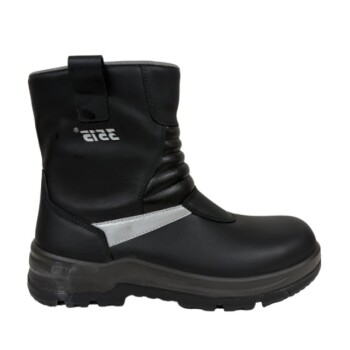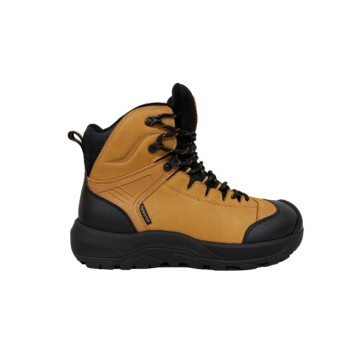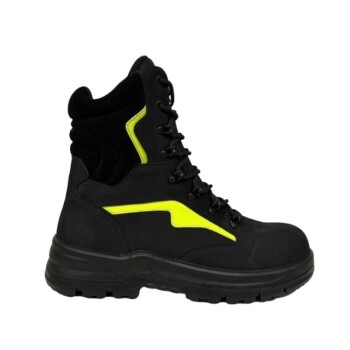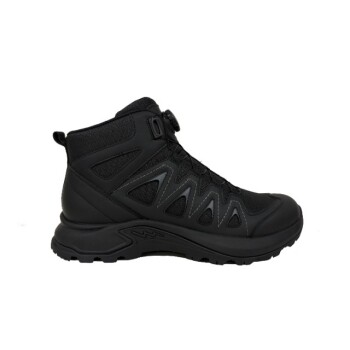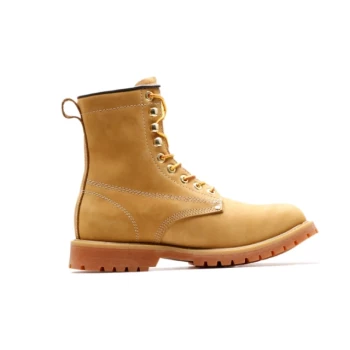In essence, an insulated boot is a type of footwear engineered with an internal layer of material specifically designed to trap heat. Its primary purpose is to create a thermal barrier that protects your feet from cold external temperatures, keeping them warm and preventing heat loss in cold environments.
The core principle is not that insulation creates warmth, but that it effectively preserves the heat your body naturally generates by trapping air within its fibers, dramatically slowing down the rate at which that warmth can escape.

How Insulation Actually Works
Understanding insulated footwear requires looking past the material and focusing on the physics of heat transfer. The goal is to stop the cold from getting in and, more importantly, stop your body's heat from getting out.
The Principle of Trapped Air
Insulation material, whether synthetic or natural, is filled with countless tiny fibers. The real work is done by the small pockets of air trapped between these fibers.
Air is a poor conductor of heat. By trapping it in a static layer, the insulation creates a highly effective buffer zone.
Creating a Thermal Barrier
This trapped air layer acts as a barrier. It slows down conduction, the process of heat transferring from your warm foot to the cold inner surface of the boot.
Simultaneously, it prevents the cold from the outside ground and air from penetrating through to your foot, maintaining a stable, warm microclimate inside the boot.
Common Insulation Materials and Ratings
Not all insulation is created equal. The type and amount of insulation determine a boot's effectiveness for specific conditions and activity levels.
Synthetic Insulation
The most common materials are synthetics like Thinsulate™ or PrimaLoft®. These use extremely fine microfibers to trap air efficiently without adding significant bulk or weight.
They are also hydrophobic, meaning they resist absorbing water and retain much of their insulating properties even when damp—a critical advantage over many natural materials.
Gram Ratings Explained
Synthetic insulation is typically measured in grams per square meter of fabric. This rating is a simple indicator of how much insulation is packed into the boot.
- 200g: Suited for cool conditions or high-activity use where your body is generating significant heat.
- 400g-600g: An excellent all-around choice for cold weather and moderate activity levels.
- 800g and higher: Designed for extreme cold and/or sedentary activities (like ice fishing or hunting from a stand) where you are not generating much body heat.
Understanding the Trade-offs
Choosing the right insulation is a balancing act. Simply picking the highest gram rating is a common and often counterproductive mistake.
The Risk of Overheating and Sweat
The most critical trade-off is warmth versus breathability. If the insulation is too heavy for your activity level, your feet will sweat.
Moisture is the enemy of warmth. Trapped sweat will eventually cool down, making your feet feel colder and clammy, which can be more dangerous than having less insulation to begin with.
The Impact on Weight and Flexibility
More insulation means a heavier and often stiffer boot. This can lead to increased fatigue over long distances and may restrict ankle movement, which is a consideration for activities like hiking or climbing.
Matching Insulation to Your Goal
To make the right choice, you must honestly assess your intended use and activity level.
- If your primary focus is high-exertion activity (winter hiking, snowshoeing): Opt for lower insulation (200g-400g) and pair it with a quality moisture-wicking sock to manage sweat.
- If your primary focus is sedentary use in extreme cold (ice fishing, stationary work): Select high insulation levels (800g or more) because you need the boot to do all the work of retaining heat.
- If your primary focus is all-purpose daily wear in a cold climate: A moderate level of insulation (200g-400g) offers the most versatility for moving between indoors and outdoors.
Ultimately, choosing the correct insulated boot is about creating a system that keeps your feet both warm and dry for your specific needs.
Summary Table:
| Insulation Level (Grams) | Best For | Key Consideration |
|---|---|---|
| 200g | Cool weather, high activity (e.g., winter hiking) | Prevents overheating and sweat buildup. |
| 400g - 600g | General cold weather, moderate activity | A versatile balance of warmth and breathability. |
| 800g+ | Extreme cold, sedentary use (e.g., ice fishing) | Maximum warmth when body heat generation is low. |
Need a reliable supplier for high-performance insulated boots?
As a large-scale manufacturer, 3515 produces a comprehensive range of insulated footwear for distributors, brand owners, and bulk clients. Our production capabilities ensure durable, comfortable, and effective boots for any climate and activity level.
Contact our team today to discuss your specific needs and get a quote for your next order.
Visual Guide
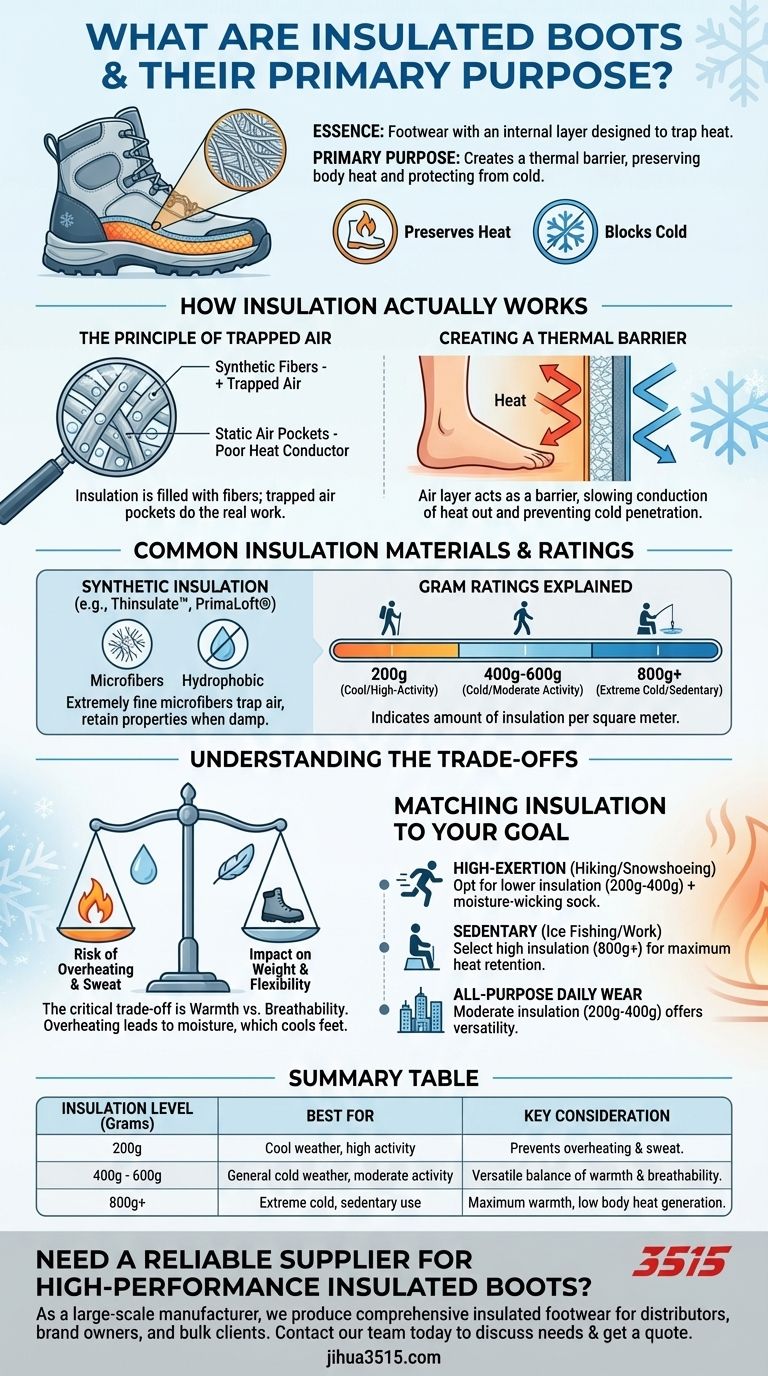
Related Products
- Safety Footwear Wholesale Manufacturer for Custom OEM/ODM Production
- Wholesale Safety Footwear Manufacturer for Bulk & Custom OEM Orders
- Premium Flame-Retardant Waterproof Safety Boots and Shoes
- High Performance Fire-Retardant Waterproof Safety Boots
- Wholesale Customizable Safety Boots Durable & Protective Footwear Manufacturing
People Also Ask
- Do snake bite boots work? Your Ultimate Guide to Effective Snake Bite Protection
- How do safety shoes contribute to cost savings for companies? A Strategic Investment in Risk and Cost Management
- Is it normal to wear shoes in the house? A Guide to Hygiene, Comfort & Culture
- What are the cultural perspectives on wearing shoes in the house? A Guide to Home Etiquette & Hygiene
- What are the differences between steel toe, composite toe, and alloy toe Wellington boots? Choose the Right Safety Toe for Your Job










